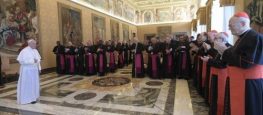
He Is Present (A Few Thoughts on Adoration)

As a child a well-loved past time activity of mine was to dig into the depths of a drawer in the wardrobe of my grandmother. Her most important treasures were hidden there: the family photos, postcards and icons. I remember very well to one of my favourites, an old postcard, turned yellow, which was sent by a lady - maybe one of my grandmother's relatives - from the capital, Budapest in 1938, from the International Eucharistic Congress. I had absolutely no ides what an International Eucharistic Congress is, but the picture amazed me, in which a lot of priest dressed in laced dresses, with altar boys, soldiers in uniform and boy scouts kneel in front of a beautifully decorated glass box. It began to raise my curiosity, what could be in that box, what deserves such a reverence.
Seeing from the outside this was my first "profane" meeting with the Eucharist would seem familiar to those tourists, wo enter the famous cathedral during the time of the adoration in one of the small chapels of the side-nave. From the outside the situation might seem odd that in the flickering light of candles people kneel before a small, white, round piece of wafer, sometime they say loud prayers together, maybe they even sing. What is really this little thing, which is surrounded with such love by the Catholic believers? What is the merit of the adoration?
Emergence of the Adoration
Adoration has a centuries-long, serious tradition within the Church. The Christians of the first centuries took a piece of the consecrated bread home, so that the sick also can take it. There are documents which tell us that St. Basil the Great (329/330-379) divided the bread into three pieces in the monastic community: one part was for the participants of the liturgy; the second part went to the sick and dying members of the community. The rest was placed above the altar in a golden holder. At that time there was no special liturgy for the veneration of the Eucharist. The veneration of the Eucharist deepened in the Church of the middle ages, because in the 11th century Berengar of Tours stepped up with the false teaching, according to which the bread and wine are merely symbols of the body and blood of Christ and there is no transubstantiation during the transformation. In order to make it clear for all member of the Church that the consecrated host is the real body of Christ, different forms of prayer came into being, where they could directly pray in front of the Holy Eucharist. Thanks to the Franciscans the reverence of the Eucharist widespread in the whole Europe from Umbria. the Eucharist was first placed on the altar in 1226 in Avignon, France, and this practice became quickly widespread in the Church The "result" of this process is the feast of Corpus Christ, which was officially established by Pope Urban IV in 1264, based on the inspiration of St. Juliana of Liège. The feast of Corpus Christi is a fest of the Eucharist, the feast of the Body and Blood of Christ. As an effect of the anti-reformation the adoration of the Eucharist grew even stronger in the Catholic Church, and at this time it became a practice to put the Eucharist in an elevated, emphasised place on the altar. In 1654, in Paris the faithful started the permanent form of the adoration, the perpetual adoration. Since the end of the 19th century the Church organises conferences in order to make Jesus present even more widespread.
During the societal changes of the 20th century it became difficult for the Church to communicate with the outside world. For example, the used forms of prayers became difficult to understand for the people. Possibly, partly because of this the reverence of the Eucharist and with this the role of the adoration in the Church decreased in many places. The II. Vatican Council in the constitution Lumen gentium expressly said that the eucharistic sacrifice is "the source and summit of the whole Christian life". The Popes of the 20th century also worked a lot on the theology of the Eucharist (Leo XII - Mirae caritatis in 1902.; Pius X. - Mediator Dei in 1947.; Pál VI - Mysterium fidei in 1965., St. John Paul II - Ecclesia de Eucharistia in 2003.). In his message to the participant of the National Eucharistic Congress in Costa Rica, Pope Francis also emphasised that the centre of the life of the Christian communities is the Eucharist.
The Church Lives from the Eucharist
The document, issued by Pope St. John Paul II deserves our special attention, not only because this encyclic of his has the most personal tone. It does not only give a teaching about the relation between the Church and the Eucharist, but the 8. article it talks about his special relationship with the Eucharist: "When I think of the Eucharist, and look at my life as a priest, as a Bishop and as the Successor of Peter, I naturally recall the many times and places in which I was able to celebrate it. I remember the parish church of Niegowić, where I had my first pastoral assignment, the collegiate church of Saint Florian in Krakow, Wawel Cathedral, Saint Peter's Basilica and so many basilicas and churches in Rome and throughout the world. I have been able to celebrate Holy Mass in chapels built along mountain paths, on lakeshores and seacoasts; I have celebrated it on altars built in stadiums and in city squares... This varied scenario of celebrations of the Eucharist has given me a powerful experience of its universal and, so to speak, cosmic character. Yes, cosmic! Because even when it is celebrated on the humble altar of a country church, the Eucharist is always in some way celebrated on the altar of the world. It unites heaven and earth. It embraces and permeates all creation. The Son of God became man in order to restore all creation, in one supreme act of praise, to the One who made it from nothing. He, the Eternal High Priest who by the blood of his Cross entered the eternal sanctuary, thus gives back to the Creator and Father all creation redeemed. He does so through the priestly ministry of the Church, to the glory of the Most Holy Trinity. Truly this is the mysterium fidei which is accomplished in the Eucharist: the world which came forth from the hands of God the Creator now returns to him redeemed by Christ." This testimony of St. John Paul II is important, because this is the first papal document ever, which talk about the cosmic dimension of the Eucharist. This dimension can help us, the man of our era to enter the spirituality of the adoration. Since this is not about we demonstrating a "Catholic" dogma (that is, that Christ is present in the Eucharist both in his divinity and humanity), but we personally meet the Son of God, our Redeemer.
The Mysticism of the Adoration
Many people complain that they do not find God in their lives. For them it can be a fixed point and good news that outside the holy mass the adoration is the occasion, when we can be sure that Jesus Christ is present for all of us. Mainly in the Middle-Ages a great number of miracles happened in connection with the Eucharist (bleeding or floating hosts, miraculous healings), and these all can also work for the deepening of our experience of faith. During the emergence of the adoration, many saints and mystics entered into a very special connection with Jesus present in the Eucharist. We can barely find any stories of vocations, spiritual experiences, where the Eucharist does not play an important role. For example, one of the favourite spiritual themes of St. Therese of Lisieux was the image of the of a ship proceeding in the light of Jesus present in the Eucharist, or in the prayer life of St. Therese of Calcutta the daily adoration was central. Adoration is not only an exclusive prerogative of the Saints, but it is a given opportunity for all of us, to meet the present Jesus. This is the very simple secret of the adoration: if I open myself to Christ, he will fill me with his presence. In the adoration we have an opportunity for a very personal relationship, with my mere presence I can answer the call of Jesus.
Adoration, as the most Authentic Practice of the Veneration of the Sacred Heart
The beginnings of the veneration of the Sacred Heart go back until the 17th century. Mary Margaret Alacoque got her divine mission for the dissemination of the veneration of the Sacred Heart during an adoration. She writes about her vision: "I forgot all about myself and the place, where I was, I got lost in the divine Spirit and all my heart was penetrated with the power of his love. He let me for a long time to rest in his heart, where he made me taste the pleasures of his love, I understood the unexplainable mysteries of his Sacred Heart, which were hidden from me until that time, and were revealed to me for the first time then in such a sensitive and efficient way, that it left not even a moment of doubt in me..." Also for Madeleine Sophie Barat, founder of the Society of the Sacred Heart adoration was of central importance, and that is why in the life of the Sacre Coeur sisters the adoration is central. The point of the veneration of the Sacred Heart is that we penetrate the inner world of Jesus, into his spirituality, into the knowledge of is desires and feelings, and on this basis we shall deepen our relationship with Christ. For we have an opportunity for this in the permanent presence of Jesus in the Eucharist, during the adoration we can meet Jesus on an existential level, and be transformed by embracing his love.
For us, the children of the modern age, the quickly changing world gives a lot of challenges and uncertainties. Jesus present in the Eucharist is an eternal safety, a corner stone, the Alpha and the Omega.
Erika Tornya RSCJ
Source: lampagyujtogato.hu











